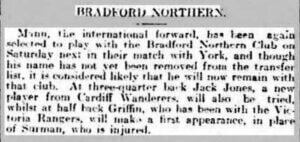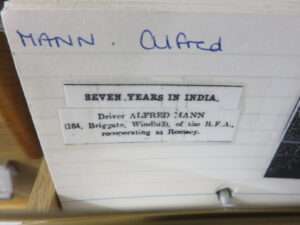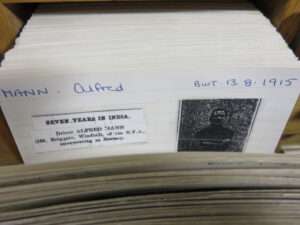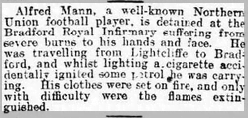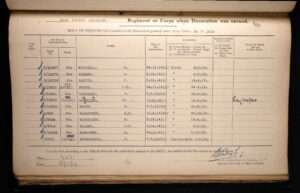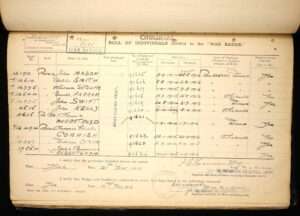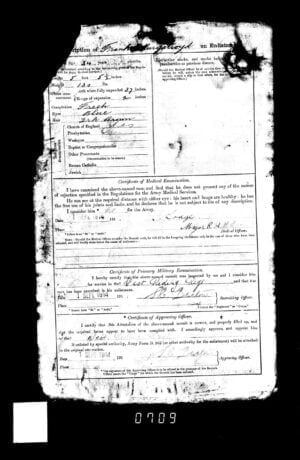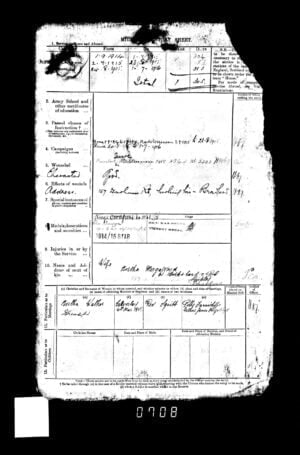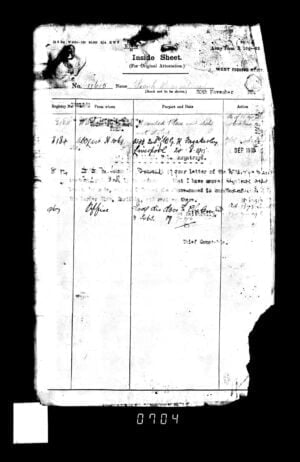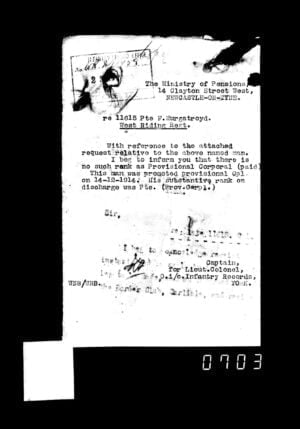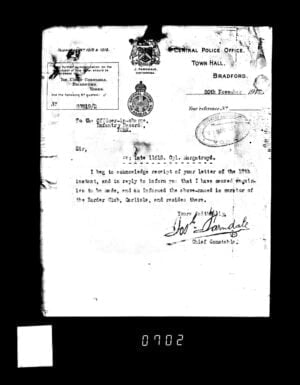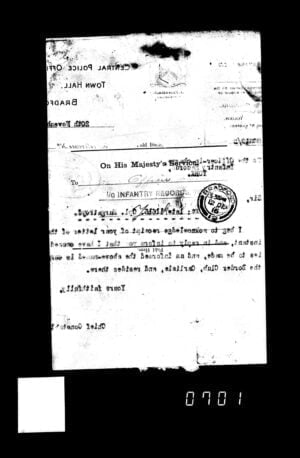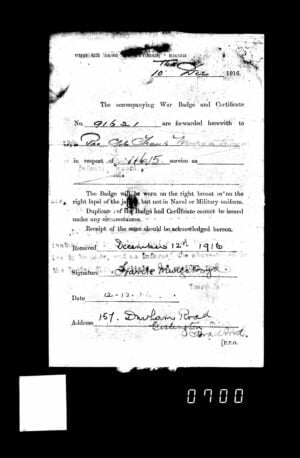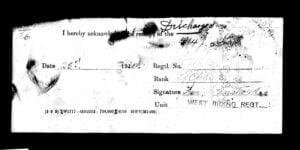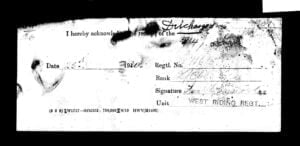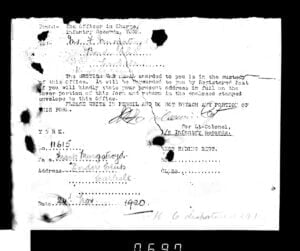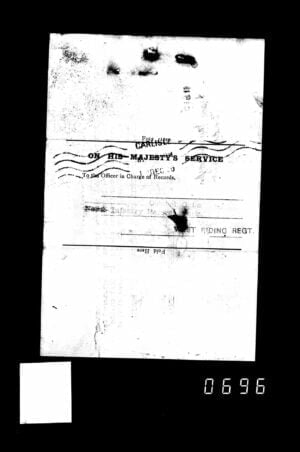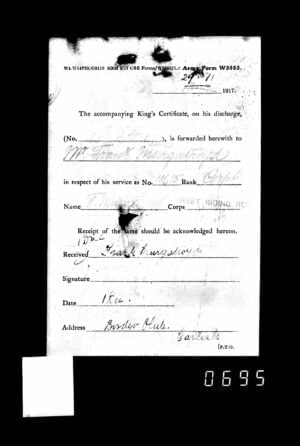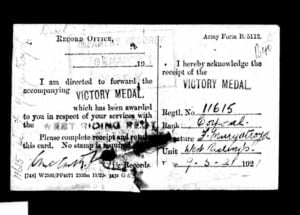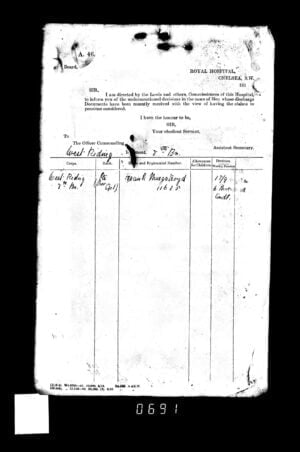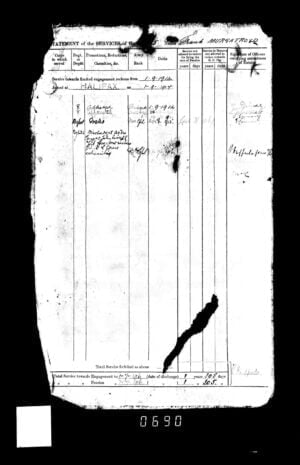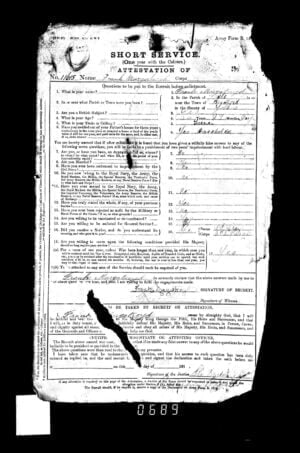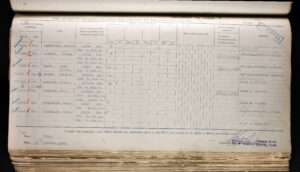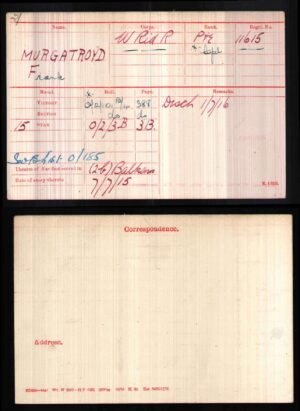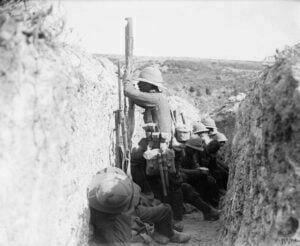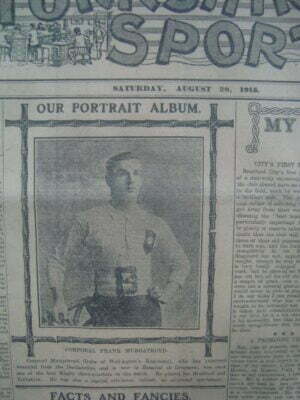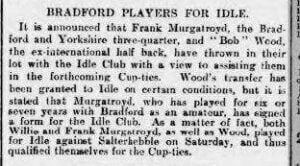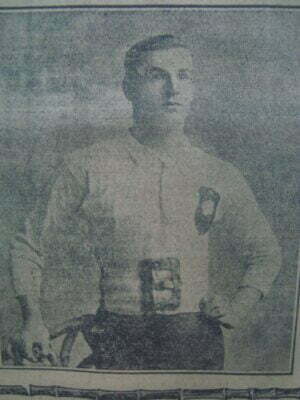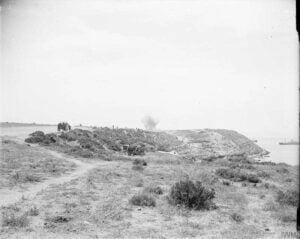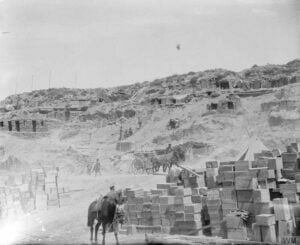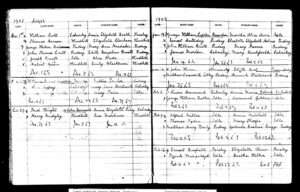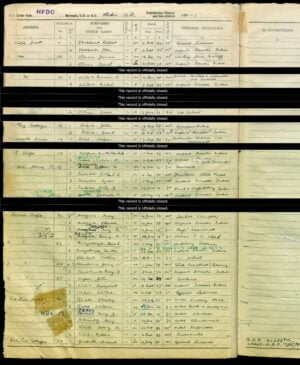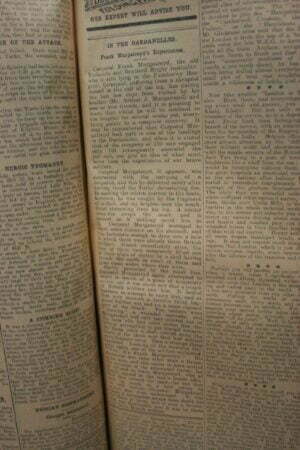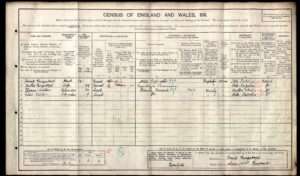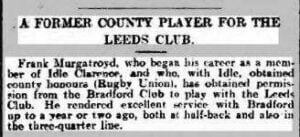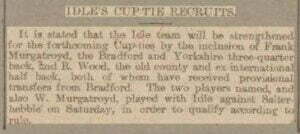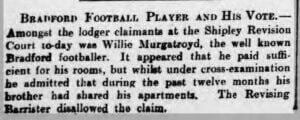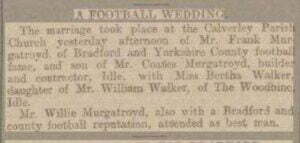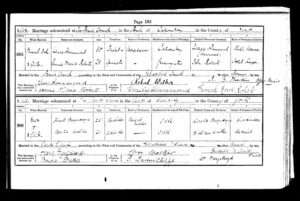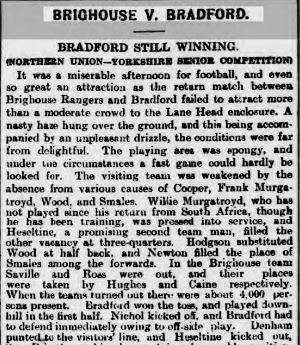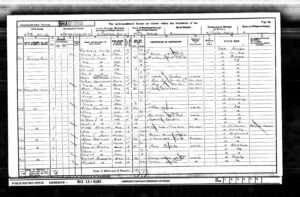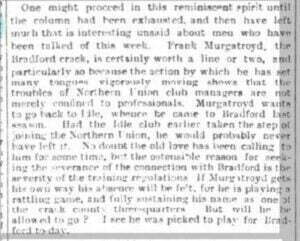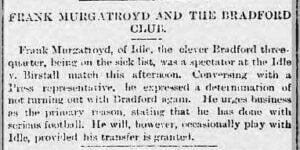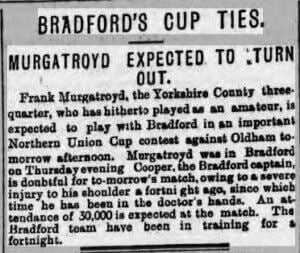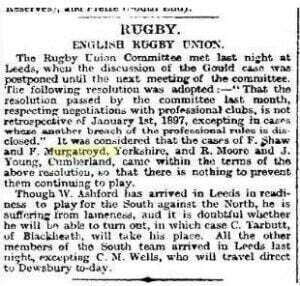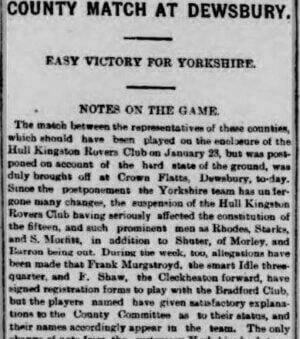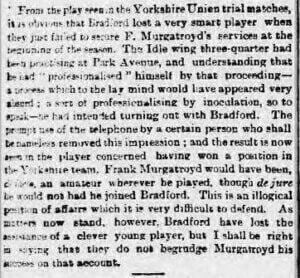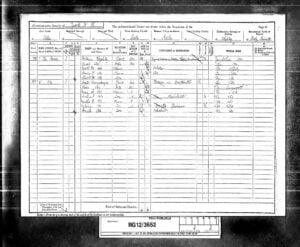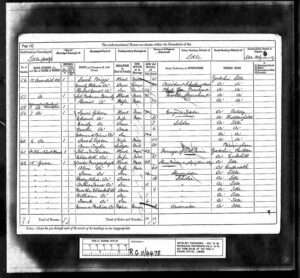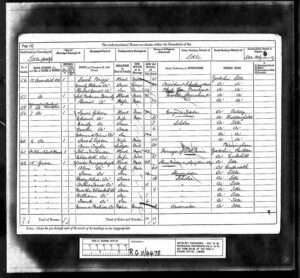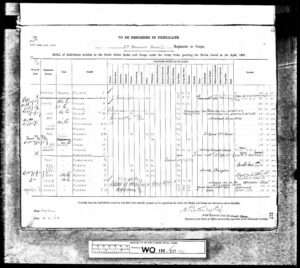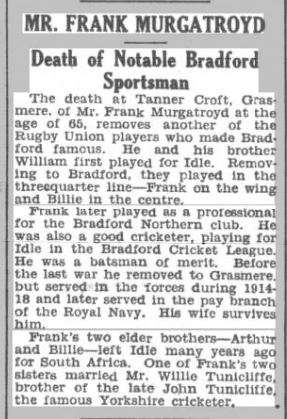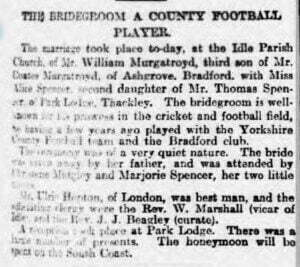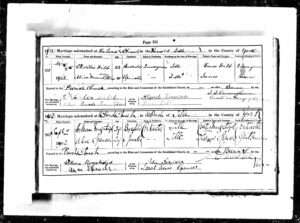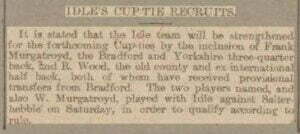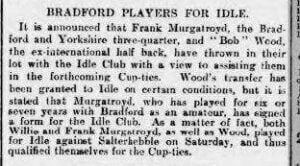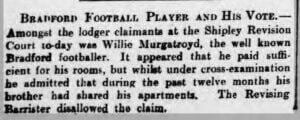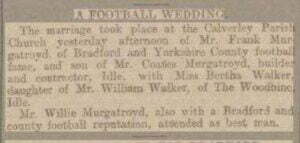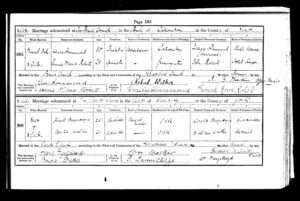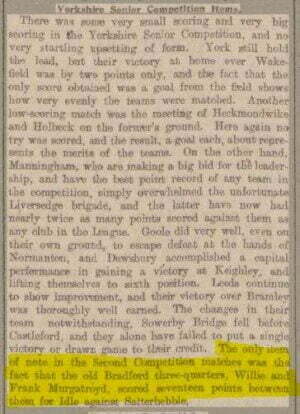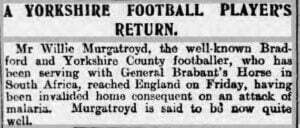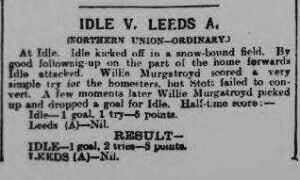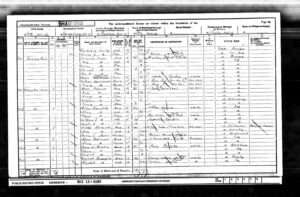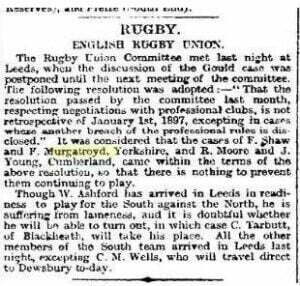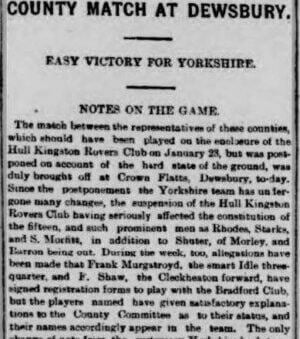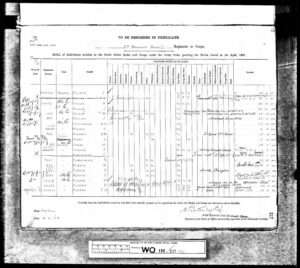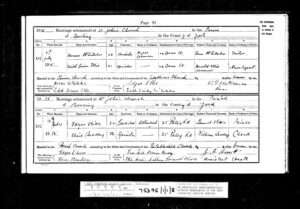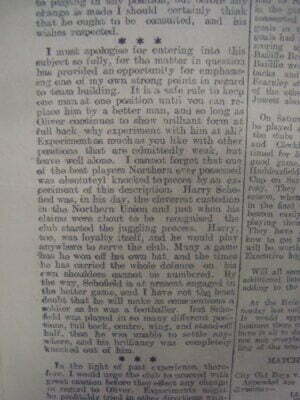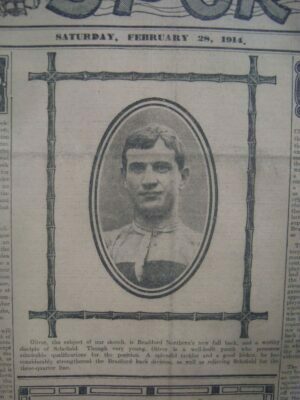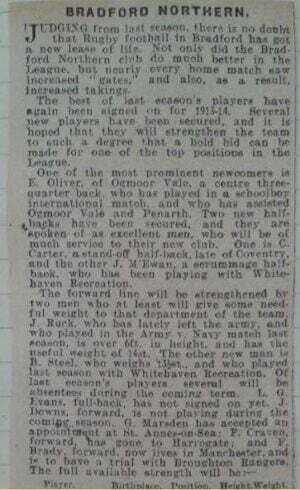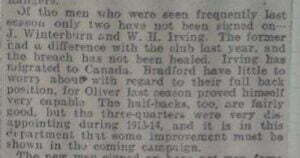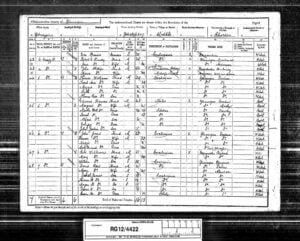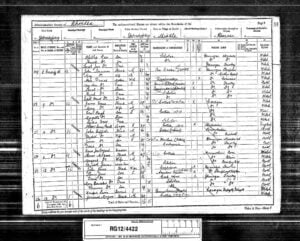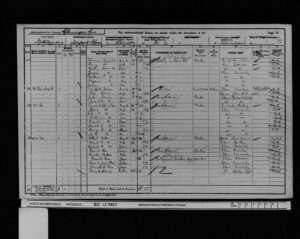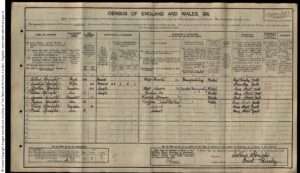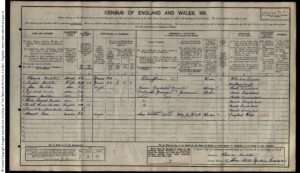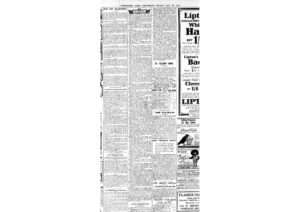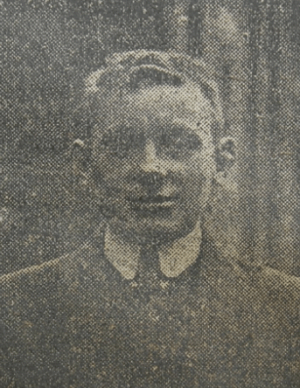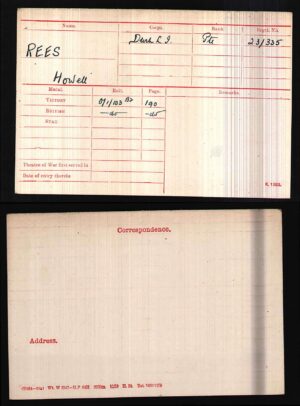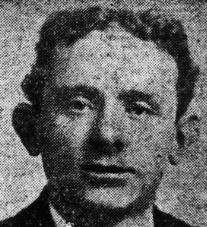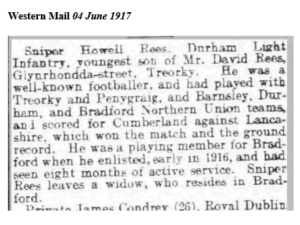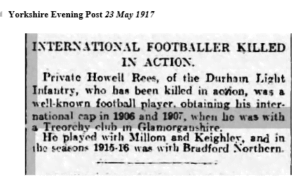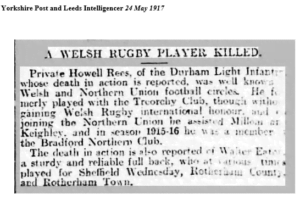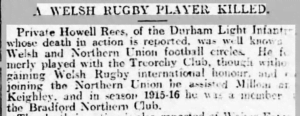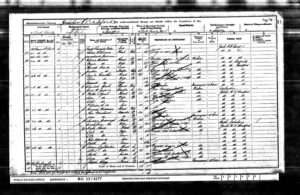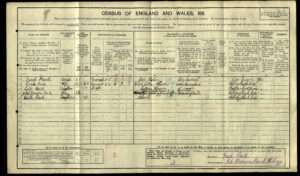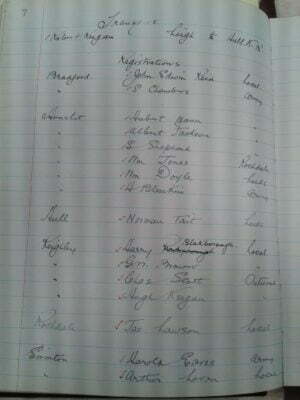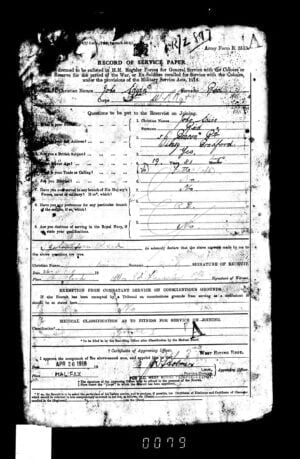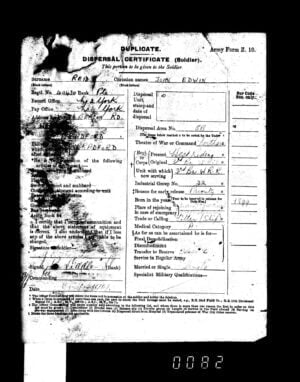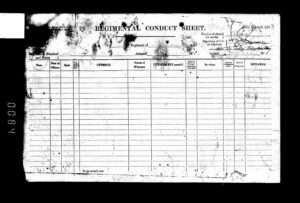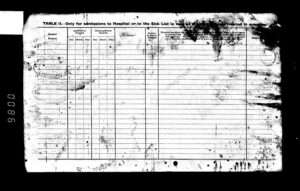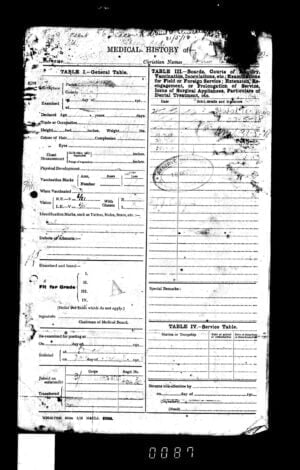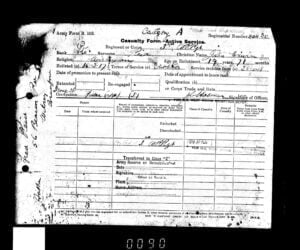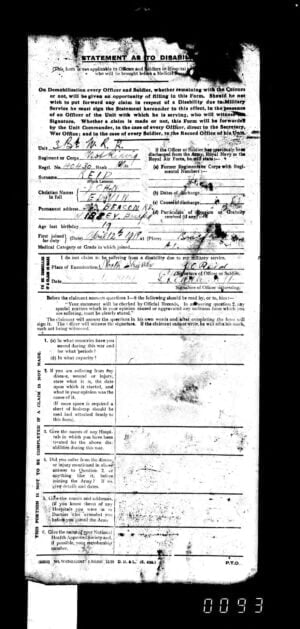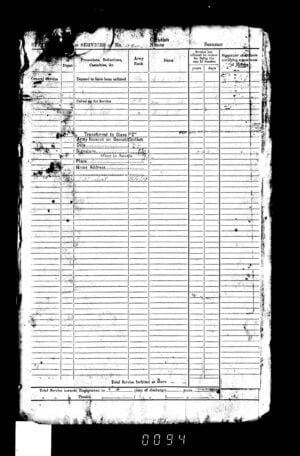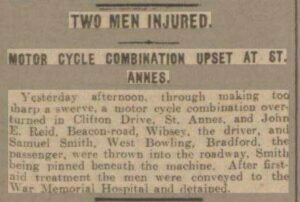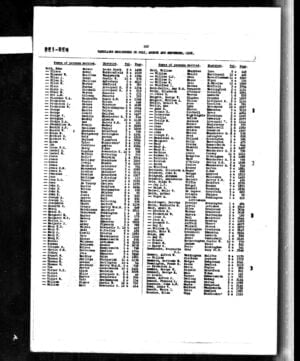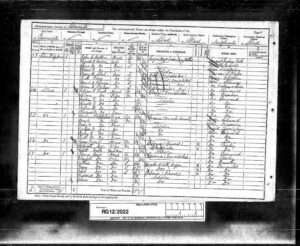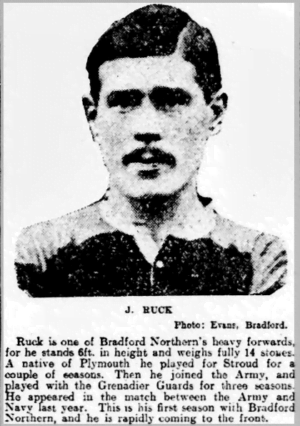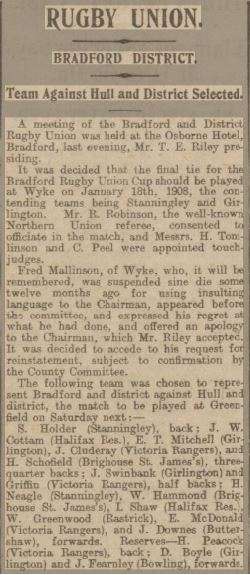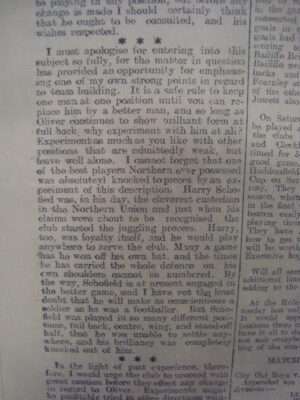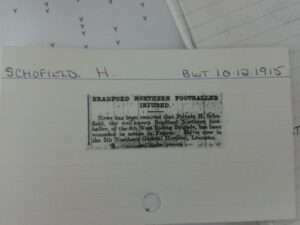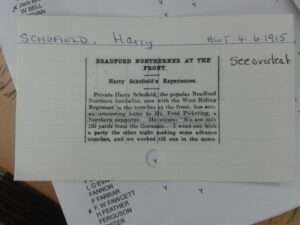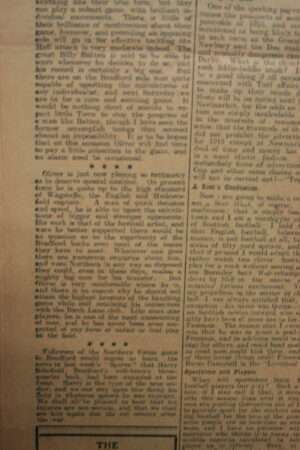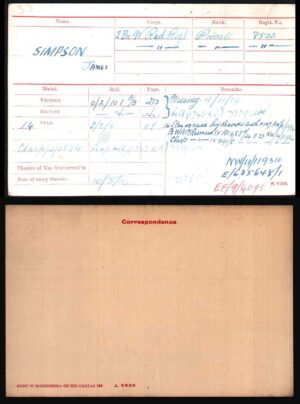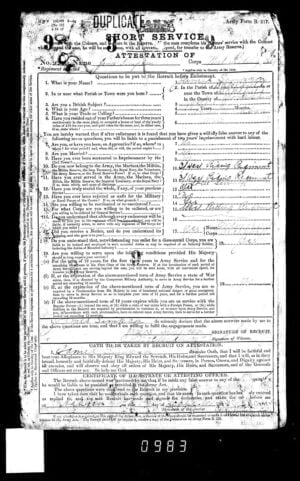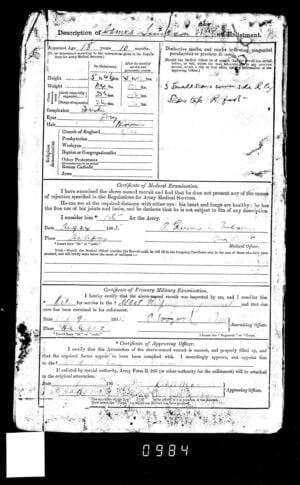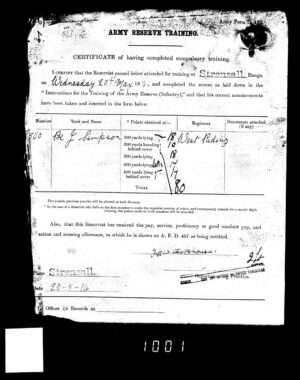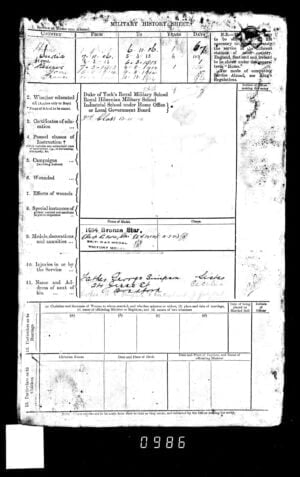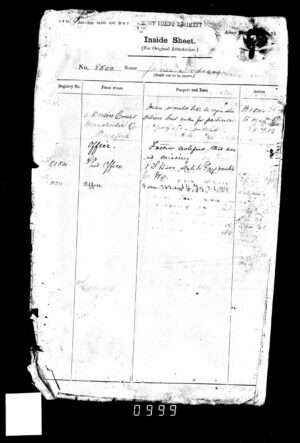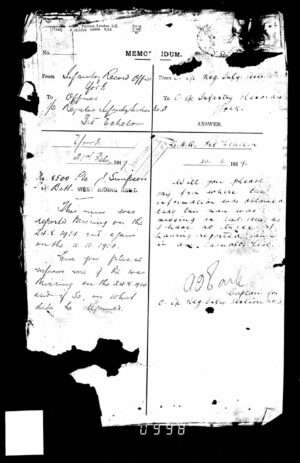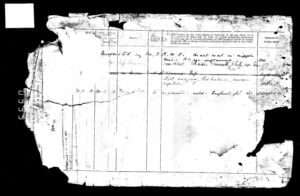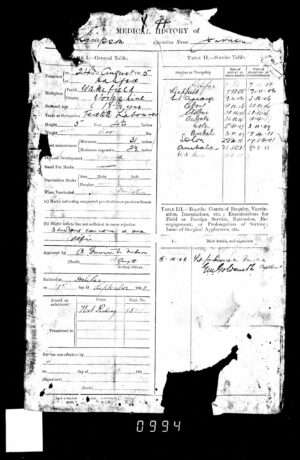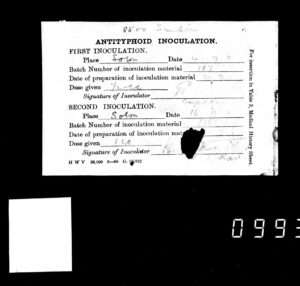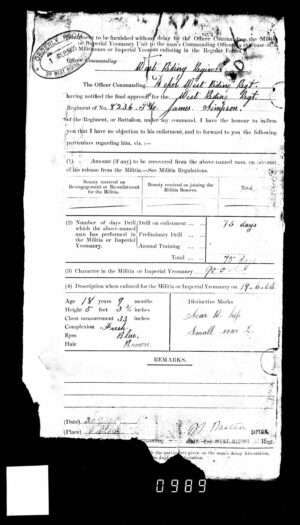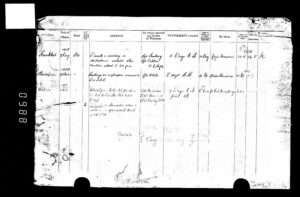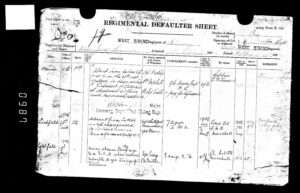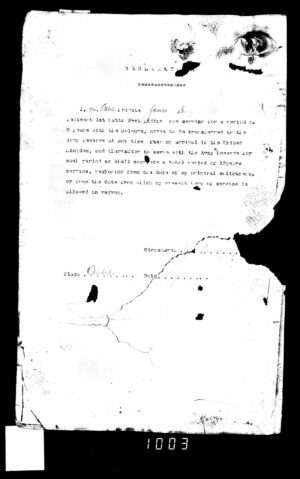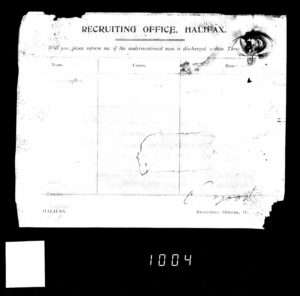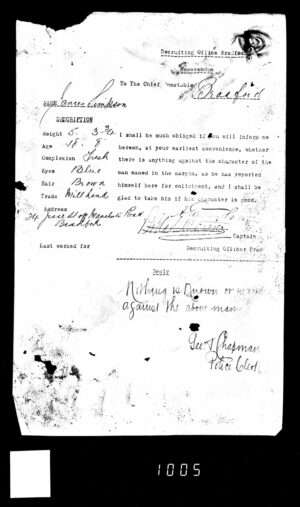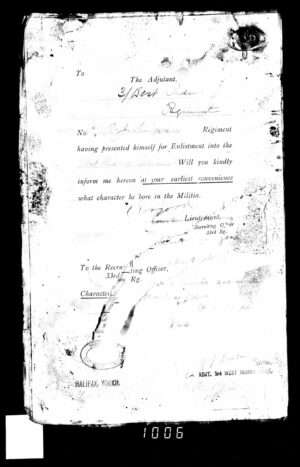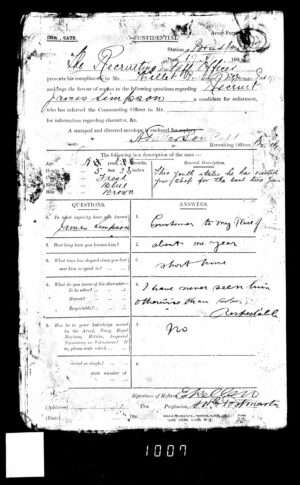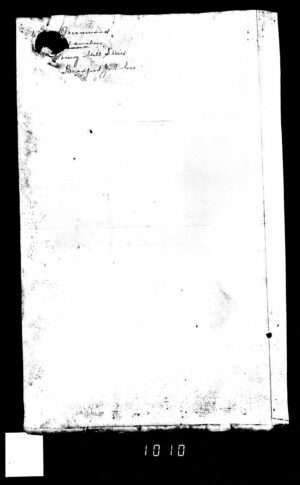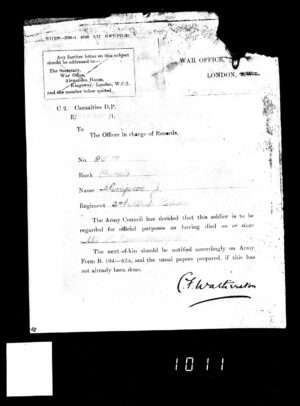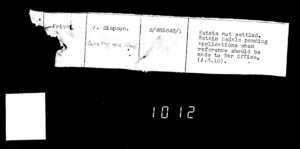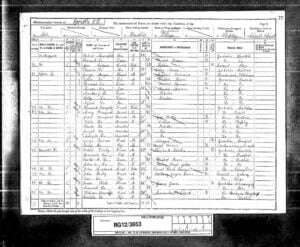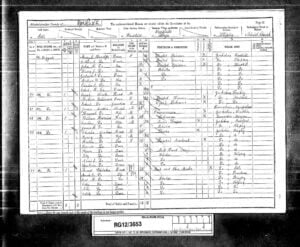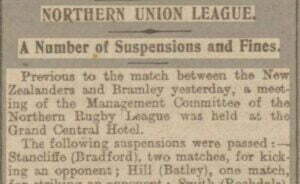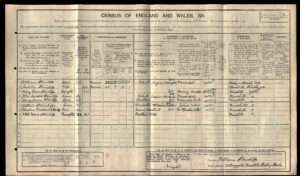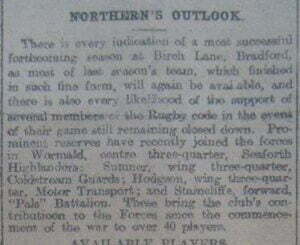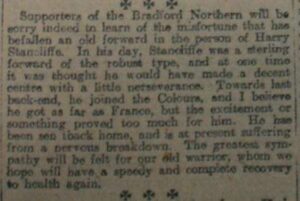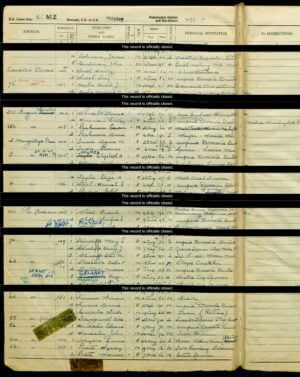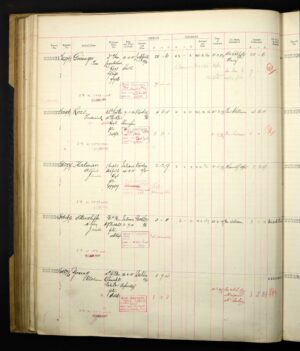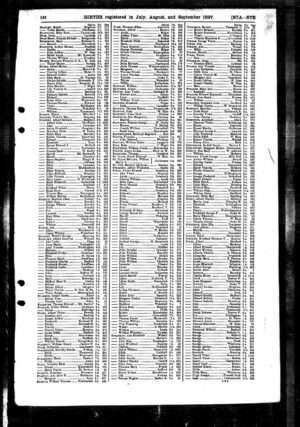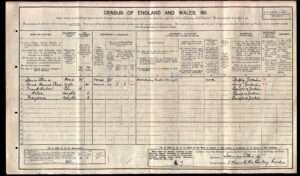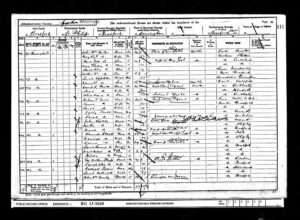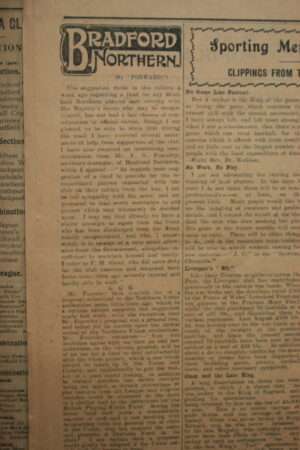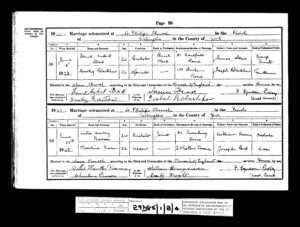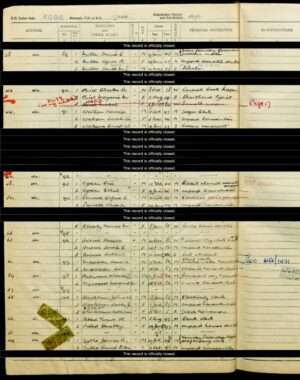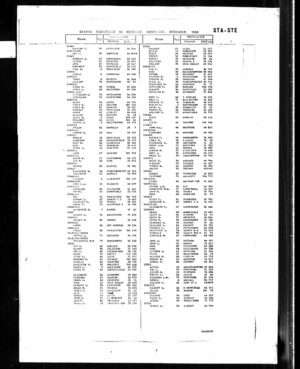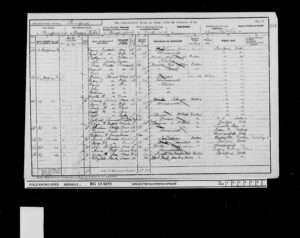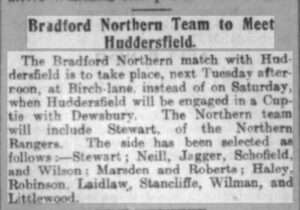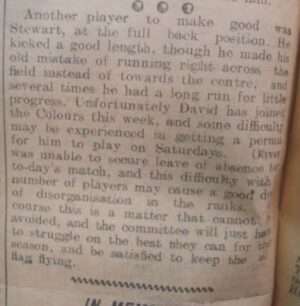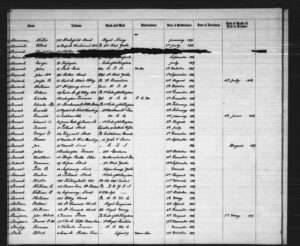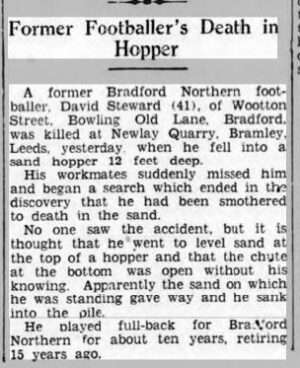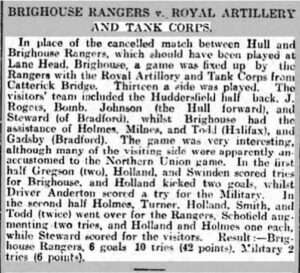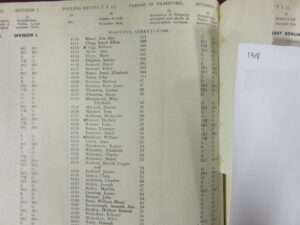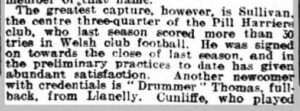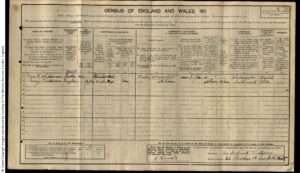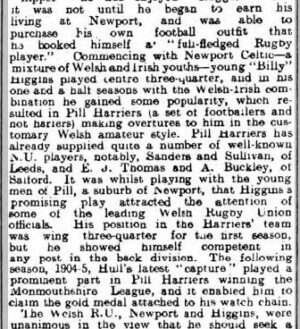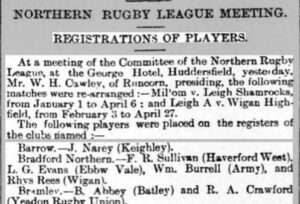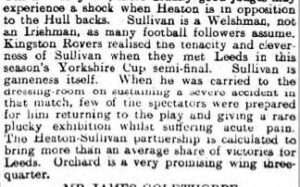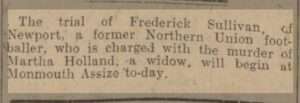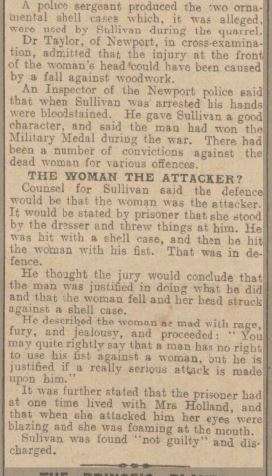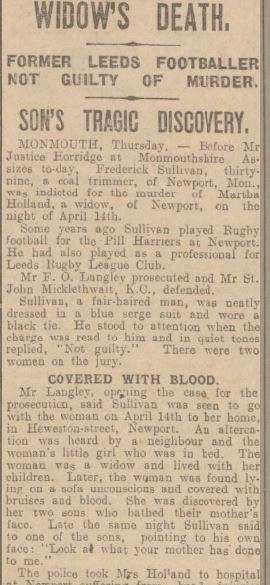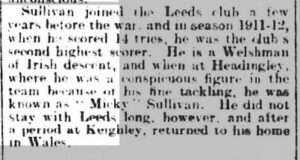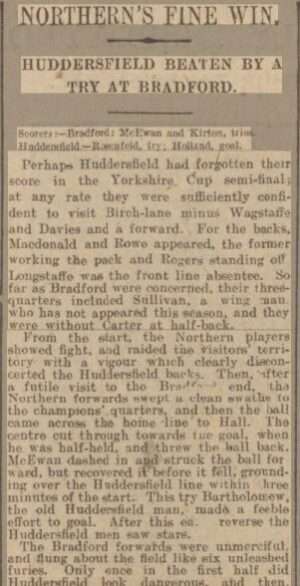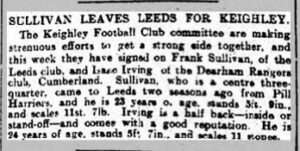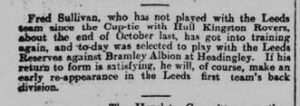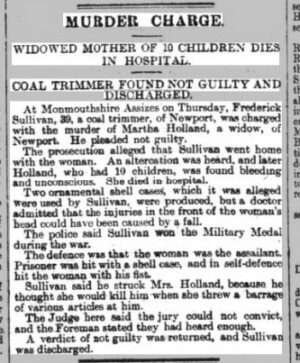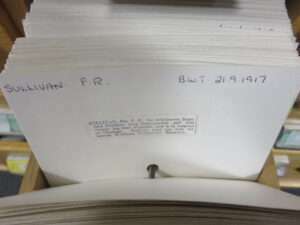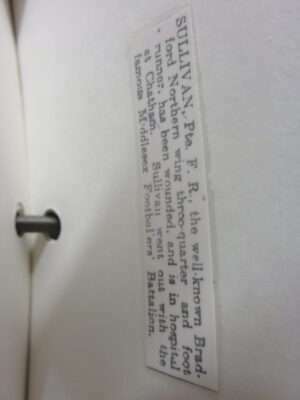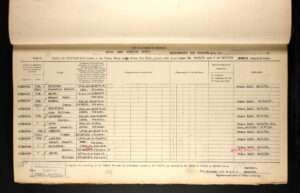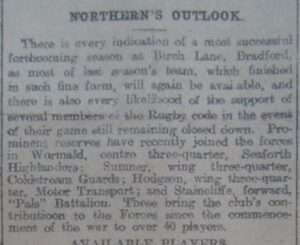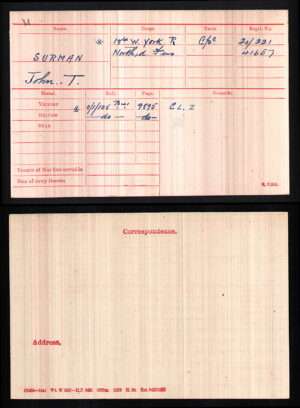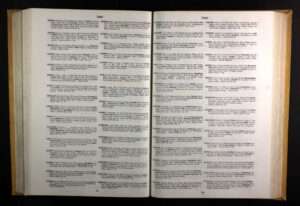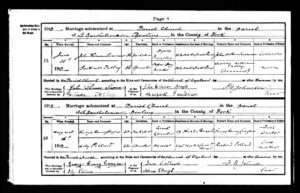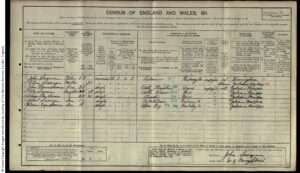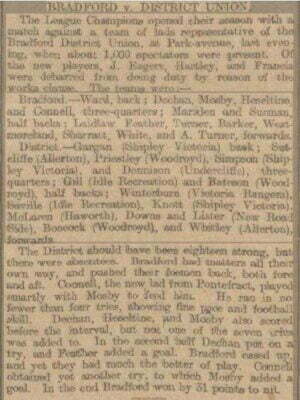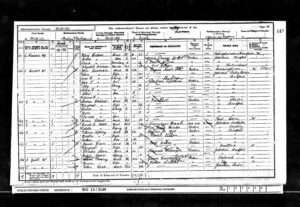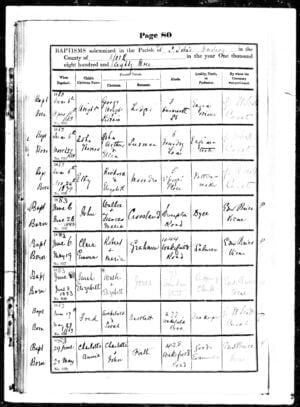

Alfred Mann
We have no photograph of Alfred Mann, other than that on to the attachment IMG6295, to be found at the bottom of this record
Personal History
We have no background history of Alfred Mann
Rugby History
He may be best known for scoring Bradford’s last try under the 15-a-side rules of the game (against Broughton Rangers on April 30th 1906) and being Bradford Northern’s first test player in the 1908/09 season, playing twice against Australia. He transferred to Hull K R 1909, but returned to play for Bradford after the conclusion of WW1.
| Season | Appearances | Goals | Tries | Points |
| 1904/5 | 2 | 0 | 0 | 0 |
| 1905/6 | 15 | 0 | 2 | 6 |
| 1906/7 | 31 | 0 | 8 | 24 |
| 1907/8 | 34 | 0 | 5 | 15 |
| 1908/9 | 22 | 1 | 11 | 35 |
| 1918/19 | 7 | 0 | 0 | 0 |
| 1919/20 | 18 | 0 | 0 | 0 |
| 1920/21 | 28 | 0 | 2 | 6 |
| 1921/22 | 14 | 0 | 1 | 3 |
| Totals | 171 | 1 | 29 | 89 |
Service History
In World War 1, Alfred served in India with the RFA (Royal Field Artillery), as a Driver
Documents
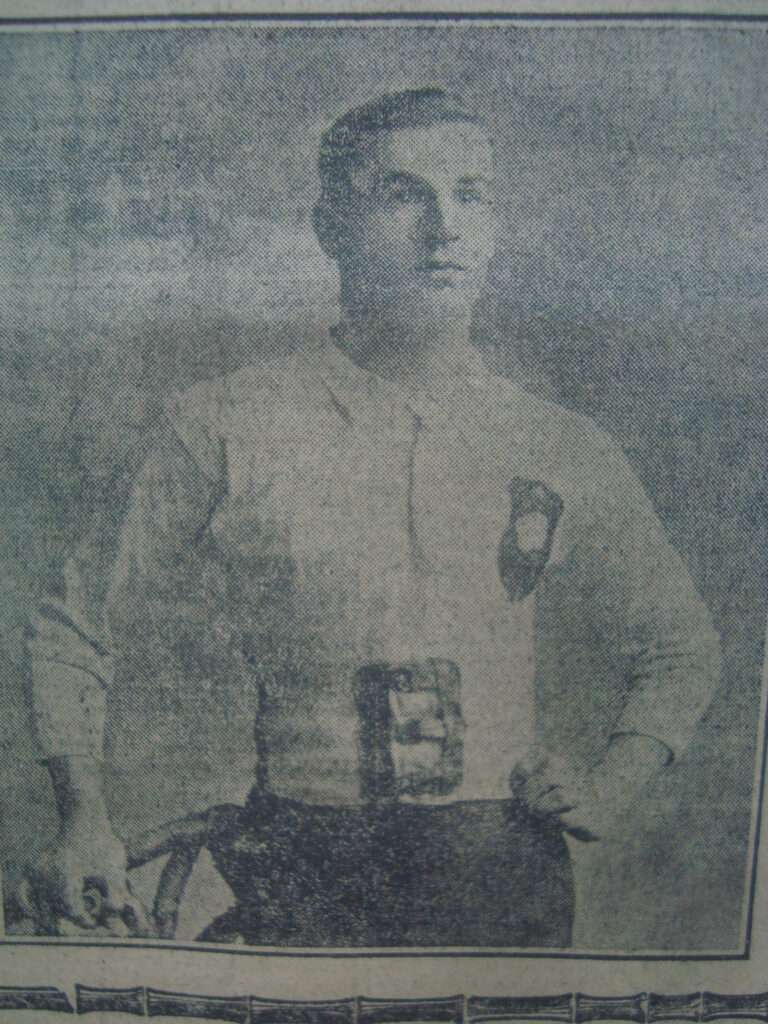
Frank Murgatroyd
Personal History
William and Frank Murgatroyd were the second and third sons of Coates and Alice Murgatroyd. Coates was a builder and contractor in Idle. The 1881 Census shows Frank at 4 years of age residing with his parents and siblings (including his brother Williiam age 7) at 15 Grove, Idle, Bradford. His father’s business was a large company winning a £100,000 contract in 1891 to build the huge goods warehouse extension to Bradford’s Midland station. Coates went on to chair the Idle local board and district council. The 1891 Census shows Frank, a scholar age 14 still residing with his parents at 8 The Grove, Idle.
By 1901 Frank (age 24) and his brother William are residing as boarders at Bradford Road, Idle and both are described as Reed Rib Makers (knitting machinery).
On the 4th of March 1903, Frank Murgatroyd married Bertha Walker at the Parish Church in Calverley. He was described as a Reed Rib Maker. His brother William was Best Man.
The Yorkshire Post in 1910 carried an advertisement for the Swan Hotel in Grasmere showing Frank Murgatroyd as the proprietor and the 1911 Census showed him aged 34 residing there with his wife.
The 1939 register shows Frank born 5th August 1876, residing at 2 Tanners Croft, Grasmere there with his wife Bertha and working as a Temporary Postman.
He became the Curator of the Border Club in Carlisle. He died at the age of 65 in 1942 in Grasmere. The Yorkshire Evening Post in November of 1942 reported his death describing him as, “a notable Rugby Union player who played for Idle and then Bradford before turning professional. He was also a good cricketer”. They also noted that after his war service he had served in the pay branch of the Royal Navy.
Rugby History
Frank Murgatroyd played his first Northern Union game for Bradford (not yet called Bradford Northern) on the 20th March 1897. The match was the first in a new cup competition embracing all 52 clubs in the Union across Yorkshire Lancashire and Cheshire. Of the matches in that first round the one between Bradford and Oldham at Park Avenue attracted great interest. Bradford has especially terraced the Horton Park portion of the ground and a crowd of over 14,000 watched the match.
Frank, a Yorkshire County player who had previously only played as an amateur, was playing left centre (4) in place of the injured captain, Cooper. Bradford won the game by 7 points to 3 and went on to beat the junior side Swinton Church. However, they were knocked out in the third round by Tyldesley despite a post-match appeal that the opposition were given a drink of beer during the match.
He played his last game for Bradford on 24th January 1903 at right centre (3) away to Salford.
Frank stayed on the Bradford books until 1905 when he transferred to Leeds.
Playing Record Bradford Northern – Frank Murgatroyd
| Season | Appearances | Goals | Tries | Total |
| 1896/97 | 3 | 1 | 2 | 11 |
| 1897/98 | 33 | 8 | 10 | 46 |
| 1898/99 | 25 | 1 | 10 | 32 |
| 1899/1900 | 31 | 0 | 1 | 3 |
| 1900/01 | 27 | 2 | 6 | 22 |
| 1901/02 | 19 | 0 | 4 | 12 |
| 1902/03 | 10 | 0 | 1 | 3 |
| Totals | 148 | 12 | 34 | 129 |
Service History
Frank Murgatroyd joined the army on the 1st September 1914 less than a month after Great Britain had entered World War 1 in response to the German invasion of Belgium (4th August 1914).
Frank was less than truthful about his age when he enlisted with the 6th West Riding Regiment as he told them that he was 34 years and 27 days old. Later research, however reveals that he was born on the 5th of August 1876 making him 38 years and 27 days old.
At the time of joining up he was described as 5’5 ½” tall, weighing 130 lbs with brown hair and blue eyes and residing in Idle, Bradford. Frank and Bertha did not have any children at the time of enlistment.
Although his early wartime service is a little vague, in January of 1915 he was posted to the Mediterranean theatre of operations and subsequently took part in the landings at the Dardanelles in Turkey. This operation was a disaster for his regiment and of the 750 men who landed only 100 subsequently answered the roll call.
After landing Frank (by now Corporal) was entrusted with carrying a despatch. After doing so safely despite devastating fire from the Turks, he attempted to return to the boats on the beach and was caught by a fragment of a shell and lay with blood streaming from his leg.
Despite a raking cross fire along the beach Frank managed to crawl some distance on his stomach and was fortunate in being able to drop into a hole that already contained three other British soldiers. Almost immediately after doing so the four soldiers were lifted completely out of the hole by a shell having struck the earth in front of them and travelling clean under where they were. Partially covered by the coastline Corporal Murgatroyd again attempted to crawl to safety and was spotted by two more British soldiers who decided to try and rescue him. Just as this was being discussed two other soldiers on another part of the beach were seen trying to carry a third man and at that moment a shell took off the heads of these three men. Frank pointed this out to his potential rescuers and suggested that any attempt would be suicidal. Just at that moment one of the men said, “Why it’s Frank Murgatroyd” and revealed that he was from Greengates. The man refused to leave Frank, who at length agreed to their heroic rescue and they carried across the soft sand on the beach and saved his life. Frank’s sporting achievements had evidently saved his life!
On the 1st of July 1917 Frank was discharged from the army as being no longer fit for war service due to the injuries he received (described as Gun Shot Wounds to the lower extremities). He was given a Silver War Badge and awarded a weekly pension of 18 shillings and 9 pence for 6 months.
Frank played his last game for Bradford in January 1903 having decided to play for Idle in the Yorkshire Cup ties. Both brothers played for Idle in a cup game against Salterhebble , scoring seventeen points between them.
Both brothers also played cricket for Idle and in the Yorkshire 2nd XI .
William Murgatroyd
Personal History
William and Frank Murgatroyd (see separate biography for Frank) were the second and third sons of Coates and Alice Murgatroyd. Coates was a builder and contractor in Idle. The 1881 Census shows William at 7 years of age residing with his parents and siblings (including his brother Frank age 4) at 15 Grove, Idle, Bradford. His father’s business was a large company winning a £100,000 contract in 1891 to build the huge goods warehouse extension to Bradford’s Midland station. Coates went on to chair the Idle local board and district council.
By 1901 William and his brother Frank are residing as boarders at Bradford Road, Idle and both are described as Reed Rib Makers (knitting machinery).
On the 4th of March 1903, Frank Murgatroyd married Bertha Walker at the Parish Church in Calverley. His brother William was Best Man.
Both brothers also played cricket for Idle and in the Yorkshire 2nd XI and William had also turned his hand to hockey in 1902 with Undercliffe (Bradford) Hockey Club.
By 1911 William had married and moved with his young family to High Wycombe, Buckinghamshire, to become proprietor of the Red Lion Hotel.
Rugby History
William and Frank Murgatroyd both played for Bradford (not yet called Bradford Northern) shortly after the formation of Northern Union. William (Willy) fought in the Boer War and Frank in the First World War.
Both brothers played Rugby Union for Idle and were part of the successful team that saw them move up from No3 competition to the No2 Championship at the end of April 1895. The also saw action in the Yorkshire County Competition however, there was concern over whether Frank would be able to continue to play for the club as “he gives promise of a brilliant future.”
In 1897, following his brother Frank who had joined them earlier that year, Willy also joined Bradford.
In May 1900 it was reported that William had gone to South Africa to fight in the Boer War and had joined the Brabant’s Horse regiment. This was a light horse unit of 600 including South African Colonials, Australians, British and Canadians. William unfortunately contracted malaria and had to be invalided home less than a year later in January 1901.
He made a full recovery and soon took up rugby training with Bradford again. Per the Yorkshire Evening Post he was pressed into service a month later, on the 23rd February, away against Brighouse as the team was suffering from several injured players his brother Frank amongst them (Contrary to official records that show that Frank not William playing in this game).
William’s last game for Bradford was on the 25th of January 1902 playing number 4 against Huddersfield. It was his only game for Bradford that season.
Frank played his last game for Bradford in January 1903 having decided to play for Idle in the Yorkshire Cup ties. Both brothers played for Idle in a cup game against Salterhebble , scoring seventeen points between them.
Playing Record Bradford Northern – William Murgatroyd
| Season | Appearances | Goals | Tries | Total |
| 1897/98 | 29 | 0 | 9 | 27 |
| 1898/99 | 31 | 0 | 9 | 27 |
| 1899/1900 | 22 | 1 | 6 | 20 |
| 1900/01 | 1 * | 0 | 0 | 0 |
| 1901/02 | 1 | 0 | 0 | 0 |
| Totals | 84 | 1 | 24 | 74 |
World War 1 History
Due to injuries sustained in the Boer War, William did not serve in World War 1

Edgar Oliver
Personal History
Edgar Oliver was born in Wales in 1893.
The 1901 Census reveals him at 8 years old living with his parents in the small village of LLangeinor, Glamorganshire, Wales.
By the age of 18 per the 1911 census he resides with family at 12, Adare Street, Ogmore Vale, Glamorgan. His occupation was shown as Coal Miner/Hewer.
On the 12th of July 1915 Edgar married Elsie Bradley at St John’s Church, Bowling, Bradford. His occupation was Attendant and he resided with his wife’s family at 25, Paley Road, Bradford.
Following his rugby career Edgar ran the Parry Lane Tavern on Sticker Lane for around 10 years before his brother in law, Norman Bradley got him a job at in the transport department of the Telegraph newspaper, a job he kept for the next 25 years.
Edgar was invited back to Bradford Northern for the opening of Odsal Stadium in 1934. His wife sadly died in 1935 leaving Edgar to bring up his two children until he remarried in 1942.
On his 60th Birthday he told a reporter that he remembered playing at Birch Lane alongside Leonard Dobson, Joe Winterburn, Jack Haley, Carter and Sturdy “his happiest memory was the day he dropped 5 goals at Birch Lane against Hull and he proudly points to the occasion when he dropped a goal which won Northern a cup match against Batley.” He continued to live in Bradford until his death in October 1955.
Rugby History
He played rugby for Ogmoore Vale as a junior and senior. He became a schoolboy international in 1907 aged just 14.
He was scouted by Fred Rennison, Northern’s trainer who signed him up to the club bringing him up to Bradford in August 1913.
At 5ft 7 and weighing 11 stone and it was reported that a “magnificent player” had joined the club. He joined the team in their preseason practice matches and he made it into the team for the Northern’s match away to Bramley on the 20th of September 1913.
By November 1914 the club was rather badly handicapped by having all their principle players away on military duty. The directors experimented with rearranging the team in December, to make up for those who were with the forces. They moved Edgar from full back to centre three quarter, his old position for Ogmore Vale, although they lost that match against Leeds he continued to play in either position.
Edgar didn’t play any matches in the first half of 1915/16. Edgar was injured by a bad knock in a match in January 1916 which gave him trouble over the next few weeks although he loyally tried to play on, he was eventually given special treatment at central baths and some rest to get fit
Edgar recovered and played out the rest of the season, however by the start of the 1916/17 season he had moved to camp with his regiment. He was allowed to return from his base in North Shields in September 1916 for a preseason and played a couple of games at the start of that season.
He only managed a couple more matches during the war before returning to play 28 games in 1919/1920. He was part of the team who played at home against Keighley, holders of the Lazenby Cup, in 1922/23 winning by 5 points to 3. The winning players were given gold medals made by Fattorini’s.
His father in law, William Bradley, became a director and secretary of Bradford Northern.
Playing Record Bradford Northern
| Season | Appearances | Goals | Tries | Points |
| 1913/14 | 20 | 0 | 0 | 0 |
| 1914/15 | 33 | 8 | 2 | 24 |
| 1915/16 | 24 | 0 | 9 | 27 |
| 1916/17 | 2 | 0 | 0 | 0 |
| 1917/18 | 1 | 0 | 0 | 0 |
| 1918/19 | 8 | 0 | 0 | 0 |
| 1919/20 | 28 | 1 | 1 | 5 |
| 1920/21 | 35 | 1 | 2 | 8 |
| 1921/22 | 28 | 1 | 2 | 8 |
| 1922/23 | 24 | 0 | 0 | 0 |
| 1923/24 | 10 | 0 | 0 | 0 |
| Totals | 213 | 11 | 16 | 72 |
Service History
Edgar enlisted with the military under the Derby Scheme in the autumn of 1915 joining the West Riding Regiment. Private 20129 Oliver served with the 2nd, 10th and 9th Regiments.
WW1 Military Hospitals Admissions and Discharge Registers show that Edgar had spent 6 months in training before being sent into the field. On the 14th of October 1917, he was transferred from the sick convoy with a shrapnel wound to his right finger. Sick convoys transported injured soldiers by train and motor transport from the Casualty Clearing Stations at the front to Military Hospitals on the French Coast for subsequent transfer to the UK. He was 24 years of age.
He was subsequently awarded the Victory and British War Medals.
Documents

John Ewart Patterson
Personal History
John Ewart Paterson was born in Bradford on July 14th 1887, to Jasper Paterson and Harriet Ashenhurst.
As a pupil he had played Rugby Union for Bradford Grammar School. He became a journalist for the local paper, ‘The Daily Argus’. He became “passionately fond” of the Northern Union game reported on the Bradford Northern games.
Census information shows John living in Baildon with his parents and Siblings up until 1911.
He joined the forces just after the outbreak of World War 1
Rugby History
John never played for the club, but he was a regular presence at the Bradford Northern games, on which he reported, the son of the manager of the Bradford Daily Argus reported on Northern’s games as ‘Discipulus’ for many years. His sound judgement and wholesome advice was always appreciated by the followers of Bradford Northern… His breezy personality making him a general favourite.”
Service History
John enlisted shortly after the outbreak of war and was soon promoted to corporal with the 18th Signalling Company of the Royal Engineers as a despatch rider and had been at the front for around 10 months. According to a newspaper report:
“On one occasion he succeeded in beating a couple of spies who had been responsible for giving signals which enabled the enemy to get the range of a certain British contingent. Single handed he rounded up these spies and handed them over to the authorities and had the satisfaction of seeing them shot. On another occasion, after travelling, roads that were sheets of ice and delivering his message he was ‘chaired’ by his comrades for his pluck.” (Bradford Weekly Telegraph 9 June 1916)
It was thought that it was during another night mission on the Somme that he collided with a French vehicle and subsequently died, age 28, in the 54 Field Ambulance on 3 June 1916. He is buried at Picquigny Communal cemetery, Somme, France. His headstone also remembers his brother 2nd Lieutenant George Gordon Patterson of the Kings Liverpool Regiment who died a few months later 25 September 1916. George has no known grave and is also remembered on Thiepval memorial.
Two other Bradford journalists had already been killed at the front Corporal Arnold Day of the ‘Telegraph’ and Second Lieutenant Eric Cave of the ‘Observer.’ It is reported that “prior to the war these three were very intimate friends and often spent their leisure time in each other’s company.”
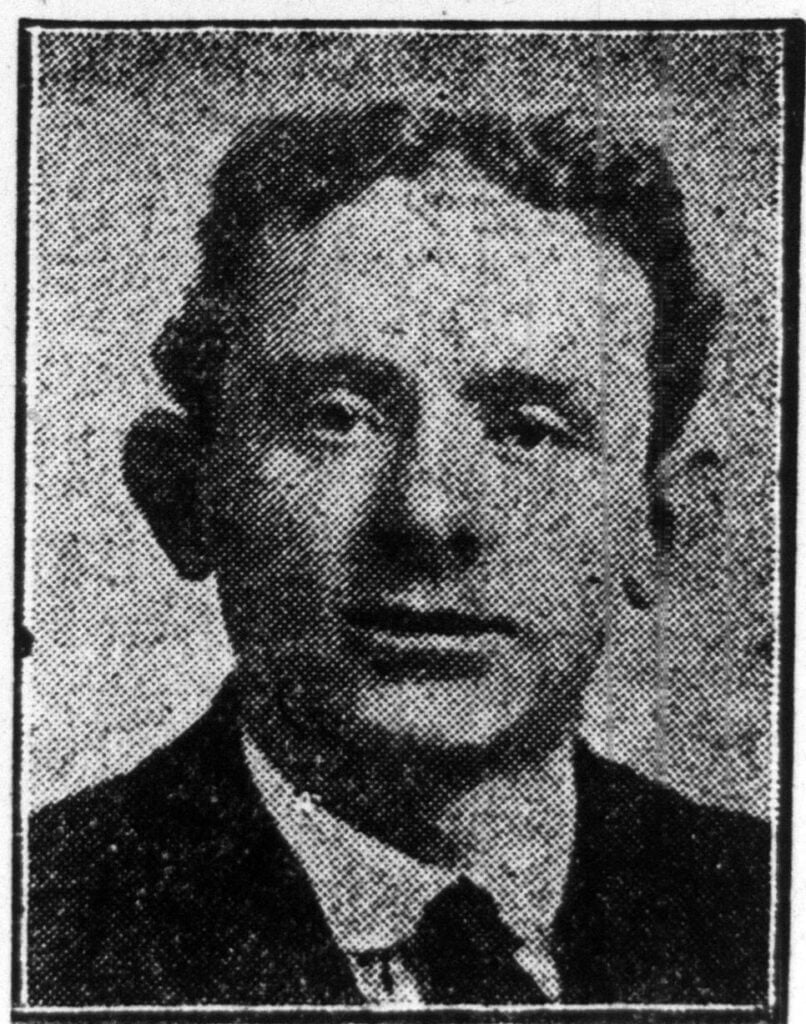
Howell Rees
Personal History
Howell Rees was born in 1886, the 7th of eight children of David and Mary Rees. They lived in the Parish of Ystradyfodwg in the Rhondda valley, Glamorgan.
By 1901 Howell’s mother had died, and he, his father and 2 of his siblings were living as lodgers at the Potter household. By this time Howell had followed his father and gone to work in the mines, being described as an Underground doorboy.
In 1911 he was to be found working (and living) in Millom in Cumberland as a general labourer in an engineering company.
He married Bertha Speight, in Bradford, in July 1916
He died on 8th May 1917, killed in action, in the battle of Arras
Rugby History
Before moving north, Howell played Rugby Union for the Treorchy and Penygraig clubs.
He played for Millom and Cumberland before moving to the Bradford area. He played for Keighley RLFC until the club folded. He then joined Bradford Northern in October 1915, but played only one match before enlisting with the army in December 1915.
Service History
Howell enlisted with the Durham Light Infantry on 11 December 1915, the penultimate day of the Derby Scheme (The Derby Scheme was the final attempt at voluntary recruitment before conscription was brought in 1916).
He weighed only 8 stone and was short at 5ft 1 and was therefore placed into the army reserve.
In June 1916 he was finally mobilised and joined the 23rd (Reserve) Battalion at Atwick near Hornsea. He took leave to marry Bertha Speight on 15th July 1916, at Tong Church.
In August 1916 he was posted with the 3rd (Reserve) Battalion at South Shields before embarking for France in October and joining the 10th (Service) Battalion, who had been in France since May 1915, on 4th November.
He was only with the battalion 5 months before he was killed in Action during the battle of Arras on 8th May 1917.
His body was never found, but he is remembered on the Arras Memorial along with 35,000 other missing servicemen from the United Kingdom, South Africa and New Zealand who died in that sector between the spring of 1916 and 7 August 1918.
John Edwin Reid
Personal History
John Edwin Reid was born on the 14th of February 1899 to Fred and Leah Reid. The 1911 Census shows that he lived with his parents and two sisters (Lily and Edith) at 56 Beacon Road, Bradford.
By the age of twelve, he was described as a part time scholar and part time doffer in a Worsted mill.
On 16th March 1917, at the age of nineteen, the 5’ 5.5’ and 11st 1lb apprentice fitter, John, enlisted with the army.
He was demobilised in January 1919 and joined Bradford Northern in the 1919/20 season
In 1936 John married Annie Vera Town in Skipton
He met an unfortunate demise at the age of 49, after collapsing while playing rugby for Wibsey, in October 1948.
Rugby History
John joined Bradford Northern in 1919, making his debut on January 1st 1920. He only made appearances in three seasons, before leaving the club.
| Season | Appearances | Goals | Tries | Points |
| 1919/20 | 2 | 0 | 0 | 0 |
| 1920/21 | 1 | 0 | 0 | 0 |
| 1921/22 | 11 | 0 | 1 | 3 |
| 14 | 0 | 1 | 3 |
Service History
Official records show that John enlisted with the army on the 16th of March 1917 at the age of 19.
He is not, however, called up for service with the 3rd Battalion West Riding (Duke of Wellington’s) Regiment until the 26th of April 1918.
His army service is relatively brief and he appears not have served abroad.
Private 40430 Reid was demobilised in January 1919.
His service was subsequently recorded in the Bradford World War One Roll of Honour.

Harold James Ruck
Personal History
Harold James Ruck was born to Clara and William Ruck, in 1889. He lived with his parents and siblings in Stroud, Gloucestershire until enlisting with the army in 1909. This meant that he moved away from the family home, to live in London.
In 1913 he returned to Gloucestershire where, to marry Edith Eliza Haywood, on 1st February at Stonehouse Parish Church.
He left the army in 1913.
He played for one season with Bradford Northern, before being called back to the army in 1914.
He was killed in action on the Somme on 26th September 1916.
Rugby History
Harold played Rugby Union for both Stroud and then the Grenadier Guards, prior to joining Bradford Northern in 1913
He signed for Bradford Northern in the August of 1913 and played for just one season. As a reservist, he was one of the first Bradford Northern players to be called up for duty, by the Army, in 1914.
| Season | Appearances | Goals | Tries | Points |
| 1913/14 | 36 | 0 | 0 | 0 |
| Total | 36 | 0 | 0 | 0 |
Service History
Harold enlisted in the army in 1909 and spent 4 years with the Grenadier Guards Welsh Regiment, before leaving the army, but remaining a reservist, in 1913.
In the Summer of 1914 He was recalled to serve in the army, and transferred to the 1st Battalion Grenadier Guards. He was recruited as a private but was later promoted to Corporal.
The Battalion was called to France as part of the British Expeditionary Force (BEF) and were involved in the race to the sea and the first battle of Ypres.
In August 1915 they became part of the Guards Division which brought the Grenadier, Coldstream, Scots, Irish and newly formed Welsh Guards together. They went on to fight in the Battle of Loos and on the Somme where Lance Sergeant Harold James Ruck was reported killed on the 26th September 1916, aged 28.
He is buried at Caterpillar Valley Cemetery, Longueval, France and is also remembered on Stonehouse memorial in Gloucester where his wife lived.
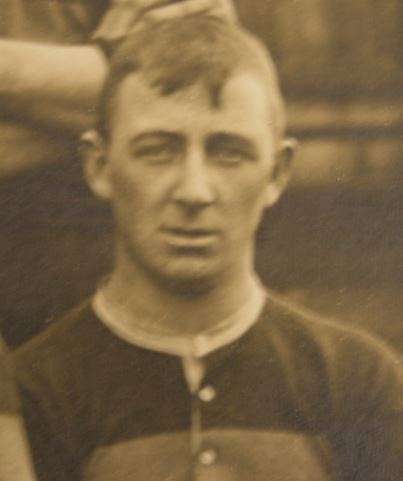
Harry J Schofield
Personal History
None recorded at this time.
Rugby History
The Leeds Mercury of 31st December 1907 reported that H Schofield, then playing for Brighouse St James, had been selected to play for Bradford and district against Hull and district at Greenfield Stadium, Bradford the following Saturday.
Harry signed for Bradford Northern on the 18th February 1908 and played until 1914, making 188 appearances, scoring 5 tries and 21 goals, for a total of 99 points. A highly rated player, he played in a variety of positions including full back, centre, wing and stand-off
Playing Record for Bradford Northern
| Season | Appearances | Goals | Tries | Points |
| 1907/08 | 10 | 0 | 2 | 6 |
| 1908/09 | 27 | 4 | 0 | 8 |
| 1909/10 | 26 | 1 | 0 | 2 |
| 1910/11 | 33 | 6 | 3 | 21 |
| 1911/12 | 30 | 2 | 4 | 16 |
| 1912/13 | 38 | 8 | 7 | 37 |
| 1913/14 | 24 | 0 | 3 | 9 |
| Totals | 188 | 21 | 19 | 99 |
Service History
In 1914 Harry enlisted in the 4th West Riding Brigade. On the 21st of November that year local newspapers reported that he had turned up at Northern’s recent game at Batley In Army uniform. They reported, “He was looking very fit indeed and expecting to go out to the front shortly” They went to say, “Schofield has fought many a hard battle on behalf of Northern and we may rest assured that he will show the same courageous spirit on the battlefield’. They further commented, “Footballers are admirably suited for soldiers for many of the principles of modern warfare are present on the football field”.
In June of 1915 Harry wrote in a letter to a Northern supporter, “We are only 150 yards from the Germans. I went out with a party the other night making some advance trenches.” “Bullets were flying all about us”, he reported, “but we all got back safely again.”
Unfortunately, his luck didn’t last, as on the 10th of December 1915 the Bradford Weekly Telegraph (Sporting Pink) reported that news had been received that Private H Schofield had been wounded in action in France and was in the 5th Northern General Hospital in Leicester.
Documents
James Simpson
Personal History
James Simpson was born in Wakefield but by the 1890s his family had moved to Bradford. He enlisted with the militia at age of 18 years and 9 months in 1905 but only served 75 days before applying to join the 2nd Battalion Duke of Wellington (West Riding Regiment).
On joining the West Riding Regiment his occupation was shown as ‘Textile Labourer’ and he was residing at 24 Jesse Street, off Manchester Road, Bradford.
He was posted to their base at Lichfield in December 1905. At time of enlistment he was described as 5’4” tall with a fresh complexion, brown hair and blue eyes. His early days with the regiment at Lichfield were a little fraught, being charged twice for being absent without leave and for using obscene language to a non-commissioned officer when ordered to ‘double’ to get his equipment (the latter charge resulted in him being confined to barracks for 8 days).
The following year he transferred to the 1st Battalion who were stationed in India. Even in India his behaviour was sketchy as his record reveals charges for Drunk and Causing a disturbance, making an improper remark to an NCO and being absent from tattoo and being found in bed at Reveille. James stayed in India until he was discharged to the army reserve in March 1913.
We know he played rugby while in the army as his is mentioned in another Bradford Northern player, Ralph Laycock’s army service record.
Rugby History
James Simpson signed with Bradford Northern in 1913/1914 on his return from serving seven years with the Army in India. He never got to play for the first team before he was called up as an army reservist at the start of the war.
Service History
On the 5th August 1914 the day after Britain declared war James was called up from the reserves to the 2nd Battalion the West Riding Regiment. He immediately went to join the Battalion where they were stationed at Portobello Barracks in Dublin.
On August 13th 1914 the battalion boarded a ship for France although delays prevented them sailing until the 14th. The journey was long and the ship crowded, they were stopped several times by French gunboats and had to wait outside La Havre harbour for several hours before they could proceed up the river. They finally disembarked in torrential rain on the 16th.
The following day they boarded trains travelling towards Belgium before disembarking and crossing the border on foot and arriving at camp in St Guislain on August 22. The battalion was to hold a front along a section of the Mons Conde Canal with the other Battalions of the 5th division of the 13th infantry brigade, the 2nd Battalion Kings Own Yorkshire Light Infantry, the 1st Battalion Royal West Kent Regiment and the 2nd Battalion Kings Own Scottish Borders.
Regimental records state, “Sunday 23rd August will for all times be a memorable one for the regiment. Things were getting very warm and it was difficult to locate the enemy or his numbers. The hopelessness of having no guns to reply with was most galling”
They did not get many rounds off before an overwhelming reply by German guns forced them back, presumably to find other positions which unfortunately didn’t exist. They reported “This opening fire was the only gun fire in our section that morning”
At dusk the firing stopped and they could hear the Germans entrenching and moving up their guns to fairly short range. At 9.55pm they received orders for the Division to withdraw and prepare trenches south of the canal demolishing bridges as they went.
At midnight under cover of darkness the battalion withdrew to Wasmes getting lost as they only had old street maps before finally taking their positions stretched across a larger area than planned. At daybreak, the battle began again with the British firing from two large 15 pounder guns.
The Germans continued and it became clear that other battalions were retiring but as no order had been received, the colonel told his men to carry on even after he was hit by three pieces of shrapnel. They continued to hold their position for an hour and a half after the order to retreat had actually been sent out but never received.
Many men were hit or missing including James Simpson.
On the 11th November 1914, he was pronounced missing presumed dead.
He is remembered on the Menin Gate Memorial at Ypres. His friend Ralph Laycock was taken as Prisoner of War in the same battle.
His family late received his medals – The 1914 Bronze Star with clasp, the British War Medal and the Victory Medal.
Documents
Henry James Stancliffe
Personal History
Henry James Stancliffe was born on the 7th of May 1882 in Windhill, Shipley.
He had eight siblings and in the 1911 Census he was living with his parents at 70, Briggate, Windhill, Shipley and was described as a riveter of galvanised tanks.
He never married and in September of 1939 he was still living with two of his sisters in Briggate, Shipley and was working as a general labourer in sheet metal.
Henry died in June of 1974 aged about 92
Rugby History
Henry signed for Bradford Northern 3rd September 1907 from the Windhill, Shipley club and he continued to be included on the list of registered players for season 1909/10.
He played his first game for Northern on 10th November 1906 at Loose Forward (13) away to Keighley which they lost 10 points to 12 although he wasn’t formally signed by the club until September 1907.
During the 1907 season Henry played every forward position except at number 12, moving from prop to hooker to second row to loose forward as required.
He was apparently a tough player as on October 10th 1907 he was reported as having been suspended for two games for kicking an opponent.
Stancliffe’s last game for the club, according to official records, was on the 21st November 1914, although the Yorkshire Sports of 28th of November reported him as playing one further game away at York, a game Bradford lost by 21 points to 3.
It was not the most auspicious occasion for his last game for the club but given that twenty players were away serving their country it was not surprising that they were not at their best.
He was still on the list of registered players for 1915/16 but did not play for the club again after November of 1914.
Playing Record for Bradford Northern
| Season | Appearances | Goals | Tries | Points |
| 1906/07 | 1 | 0 | 0 | 0 |
| 1907/08 | 15 | 0 | 2 | 6 |
| 1908/09 | 19 | 0 | 2 | 6 |
| 1909/10 | 25 | 0 | 3 | 9 |
| 1910/11 | 25 | 0 | 0 | 0 |
| 1911/12 | 18 | 0 | 1 | 3 |
| 1912/13 | 26 | 0 | 1 | 3 |
| 1913/14 | 0 | 0 | 0 | 0 |
| 1914/15 | 7 | 0 | 0 | 0 |
| Totals | 136 | 0 | 9 | 27 |
Service History
Although Henry’s army record is sparse, he was reported in the Yorkshire Sports of August 14th 1915 as having joined the Bradford ‘Pals’ Battalion. At the time of enlisting he was described as 5’9’’ tall and weighing 12st 2lbs
His Regimental number is a Territorial Force one (possibly even pre-war) and not one from the Pals. He is not listed in the first 1000 of the Pals, quite a few of whom seemed to end up in other battalions.
The 1/6th West Yorks (Bradford Pals) did go to France in April 1915, but he is not listed there.
It seems that his time in the army was a little troubled and on October 2nd 1915 the Yorkshire Sports told their readers, “Supporters of Bradford Northern will be sorry indeed to learn of the misfortune that has befallen an old forward in the person of Henry Stancliffe.
In his day, Stancliffe was a sterling forward of the robust type, and at one time it was thought that he would have made a decent centre with a little perseverance. Towards last back-end, he joined the Colours, and I believe he got as far as France, but the excitement or something proved too much for him. He has been sent back home, and is at present suffering from a nervous breakdown. The greatest sympathy will be felt for our old warrior, whom we hope will have a speedy and complete recovery to health again.”
Private 4684 Henry James Stancliffe of the 3/6th Battalion West Yorkshire Regiment official army records was transferred to 1st Yorkshire Regiment and was discharged from the army on the 3rd September 1915 having been declared insane.
The £3 and 11 pence pay he was owed in February 1917 was sent to his father William who died in June of that year.
Documents
Frank Hubert Stead
Personal History
Frank Hubert Stead was born in Bradford on the 2nd of August 1897.
The 1901 Census reveals him age 3, living with his parents and grandparents at 261 Kensington Street Bradford. By 1911 at age 13, he was residing with his parents at 3, Knowle Road, Burley, Leeds.
On June the 6th 1923 Frank Hubert Stead age 25 (a bank clerk) married Dorothy Robertshaw at St Philips Church, Girlington. He was residing at 51, Westfield Road, Girlington at the time.
Records show that Frank Stead died in Bradford in 1966.
Rugby History
It would seem Frank Stead didn’t play in the first team, but the Yorkshire Sports of the 4th December 1915 commented that Mr F.N Fearnley the secretary/manager of Bradford Northern had suggested a fund be set up to support incapacitated players connected with the club on their return from the war.
The writer ‘Forward’ reported that he fully supported the scheme and said, “I may say that we have a player amongst us again from the front who has been discharged from the army fully incapacitated and who is in receipt of a very small allowance from the Government altogether insufficient to support him and his family. I refer to F.H. Stead who did some duty for the club reserves and returned back some time ago severely injured and barely able to walk.”
Service History
As above. No further information at this time.
Documents
David Steward
Personal History
David was born 1st July 1892 in Bradford. His parents at the time lived in Heap Lane, Wapping, Bradford. By the time of the 1901 Census he was living with his family at the former Union Cross Inn in Wapping Road. In the 1911 Census, he still resides with his family in De Grey Street, Undercliffe, Bradford and is 18 years of age and described as a Dyers Labourer.
David died in 1935 aged 41 in a work accident, tragically falling into a sand hopper at the Newlay Quarry in Bramley. He left a widow Ethel and a 19 year old, son who had recently signed for Bradford Park Avenue.
Rugby History
A product of Bradford school’s rugby football, David Steward played his first game for Bradford Northern at age 18 at home to Huddersfield on the 8th of November 1910 having joined Northern from the amateur club Bradford Rangers. He played Full Back, a position he retained throughout his career with Bradford.
On the 18th of February 1918, the Yorkshire Post reported that in the game played on the 16th at Birch Lane against Hull Kingston Rovers “None played better than Steward, whose try from an individual effort was the best seen on the ground this season. Securing possession at the centre he kicked well forward, ran along, regained possession and brushing aside all opposition scored a magnificent try.” Bradford won by 19 points to nil with Steward kicking two goals in addition to scoring a try.
The Yorkshire Post also reported on the 4th of March 1918 that in place of a cancelled game against Hull, Brighouse Rangers played a 13 a side game, against a team from the Royal Artillery and Tank Corps from Catterick. Made up of players including some from Northern Union clubs, the Army team included Steward from Bradford. Brighouse won easily beating the Army by 42 points to 6, however, Steward scored one try for the Army.
He continued to play for Bradford until 1921, playing his final game for Northern on the 5th of November that year at home to Bramley.
During his period with the Club he also was ‘loaned’ to Leeds, Hunslet, Wakefied and other Clubs.
Playing Record for Bradford Northern
| Season | Appearances | Goals | Tries | Points |
| 1910/11 | 17 | 6 | 0 | 12 |
| 1911/12 | 19 | 3 | 0 | 6 |
| 1912/13 | 18 | 1 | 1 | 5 |
| 1913/14 | 1 | 0 | 0 | 0 |
| 1914/15 | 2 | 0 | 0 | 0 |
| 1915/16 | 0 | 0 | 0 | 0 |
| 1916/17 | 3 | 0 | 1 | 3 |
| 1917/18 | 24 | 16 | 3 | 41 |
| 1918/19 | 23 | 8 | 2 | 24 |
| 1919/20 | 9 | 0 | 0 | 0 |
| 1920/21 | 0 | 0 | 0 | 0 |
| 1921/22 | 10 | 1 | 1 | 5 |
| Totals | 126 | 35 | 8 | 96 |
Service History
On the 23rd of September 1916 a newspaper reporting on the game away to York on that date, commented, “Another player to make good was Steward at Full Back”, but then went on to say, “Unfortunately David has joined the Colours this week and some difficulty may be experienced in getting a permission for him to play on Saturdays”.
The National roll of the Great War later recorded, that Private D Steward of the King’s Liverpool Regiment volunteered in September 1915 and on completion of his training was sent to Ireland. After serving there until December 1916 he returned to England and was employed on special duties with his unit. He did very good work but was not successful in obtaining his transfer to a theatre of war and was demobilised in December 1918. At the time he was recorded as living at 105, Wootton Street, West Bowling, Bradford.
Documents
Frederick Ronald Sullivan
Personal History
Frederick Ronald Sullivan, was known as ‘Micky’ due to his Irish decent, even though he was a Welshman.
In 1928 Sullivan was charged with the murder of Martha Holland in Newport on the night of Saturday 14th April. However, he was found not guilty and was later discharged.
Rugby History
He signed for Bradford Northern on 27 February 1912 as a wing three quarter. He had previously played for Pill Harriers where he had scored more than 30 tries in Welsh club football.
In the 1911-12 season, he made 5 appearances for Northern but then played for Leeds, scoring 14 tries before moving to Keighley in July 1913.
He next appeared for Bradford in the in 1913-14 season when he played one game against Huddersfield.
Playing Record for Bradford Northern
| Season | Appearances | Goals | Tries | Points |
| 1911/12 | 5 | 0 | 0 | 0 |
| 1913/14 | 1 | 0 | 0 | 0 |
| Totals | 6 | 0 | 0 | 0 |
Service History
Private 1389 Sullivan joined the 17th (Footballers) Battalion of the Middlesex Regiment. On the21st September 1917, the Bradford Weekly Telegraph reported that he had been wounded and was in hospital in Chatham.
The 17th (Service) Battalion, Middlesex Regiment was an infantry battalion of the Middlesex Regiment, part of the British Army, which was formed as a Pals battalion during the Great War. The core of the battalion was a group of professional footballers, which was the reason for its most commonly used name, The Football Battalion.
On the 28th of January 1918, he transferred to the Army Service Corps. He was awarded the British and Victory Medals and the 1915 Star (he was sent to France on 17.11.15).
Documents
Sumner
Personal History
Not known. First name not known.
Rugby History
Not known, however the Yorkshire Sports of 14th August 1915 reported, ‘Prominent reserves (Bradford Northern Reserves) have recently joined the Forces (including) Sumner, wing three quarter, Coldstream Guards. These bring the club’s contribution to the Forces since the commencement of the war to over 40 players’.
Service History
As above, no further information at this stage i
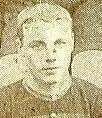
John Thomas Surman
Personal History
John Thomas Surman was born on the 23rd of March 1883 and baptised at St John’s Parish Church, Bowling on the 6th of June that year. His parents, John Arthur and Ellen Surman were residing at the time at 6, Foundry Lane, Bradford. His father’s occupation was Engine Tenter.
By the time of the 1901 census the family had moved to 11, Heaton Street and 18 year old John Thomas (Tommy) was recorded as working in the Piece Room of a Dyehouse.
On June 28th 1919, 36 year old, John Thomas Surman, married Gertrude Tetley at St Bartholomew’s Church, Bowling. He was shown as living at 254, Wakefield Road and employed as a Dyers Finisher.
John Thomas Surman died on the 28th of January 1948 at his home at 2, Derwent Place, Bradford. He left his estate of £1871 19s 6d to his widow Gertrude.
Rugby History
Tommy is first recorded as turning out for Bradford in the 1902/03 season during which he made 6 appearances. His first game for the club was on November 1st 1902 at home against Broughton Rangers, a game Bradford lost by 8 points to nil.
On September 2nd 1904, The Leeds Mercury reported on a game between the Bradford Club (League Champions) and lads representative of the Bradford District Union. The match played at Park Avenue was enjoyed by around 1000 spectators. It also reported that Surman had played at Half Back and that Bradford had won the game by 31 points to nil.
Surman progressively improved as seasons went by and in the 1906/07 season, making 32 appearances, he kicked 26 goals and scored 13 tries, accumulating a total of 91 points, his best season to date, the Club’s highest point scorer that season.
Although Tommy continued to play for Bradford right up to the 1908/09 season things did not always run smoothly between Tommy and the club, evidenced by the fact the Manchester Courier of September 24th 1907 reported, “The Bradford Northern Club have been sadly handicapped by the refusal of Surman, last year’s Captain, to turn out”.
The problem must have been resolved as on the 28th of September that year, for the first time that season, Tommy played for Northern away to Wakefield Trinity. Although Bradford lost by 21 points to 5, Surman, playing on the right wing, managed to get his name on the score sheet by kicking a goal. He went on to make a total of 31 appearances that season scoring 18 goals and 11 tries to make a total of 69 points. Again, he was the highest points scorer of the season.
Despite this hiccup, Tommy continued to play consistently for Bradford until he became caught up in scandal that was to rock the club and Surman himself.
In February of 1908 the club appointed a new, full time secretary, W Bayliss. This turned out to be a bad move for the club as, in November of 1908, Bayliss informed two players Alfred Mann and Tommy Surman that the club was in a financial plight and that they were going to be transferred as the club needed the money to stop them going into extinction.
The three men first travelled to Leeds and Bayliss offered them the two players for a sum of £150 in gold coin. Leeds refused and Bayliss would not come down in price so the deal did not go through. Next, they travelled across to Humberside and Bayliss opened up discussions with Hull Kingston Rovers but dropped the asking price to £120 in cash. Hull KR agreed there and then and gave Bayliss the money. He then pulled the two players on one side and gave Surman £25 and Mann £20 saying it was a bonus to them for long and loyal service, a practice that was illegal under the rules of the game.
Two days later the Bradford Northern committee met to choose their side to play St Helens the next Saturday. When they asked why Mann and Surman had not turned up for training they were amazed to hear from the other players about their transfer. They knew nothing about it nor had they any intention of selling the two players. They immediately contacted Hull KR and the Northern Rugby Football League to inform them of the position.
Word was then sent for Bayliss to clear up the situation but he was nowhere to be found. With £75 in his pocket he had disappeared without trace.
Both Bradford and Hull KR claimed that the players were registered with them and the matter had to settled by the NRFL. They concluded that technically both players belonged to Hull KR as all the paperwork had been signed by a representative of Bradford Northern. They said, however, that both players could return to Bradford if the club paid Hull KR £82 10s to cover the cost of transferring the players back to Bradford and half of the £75 still missing with Bayliss from the original £120. They also decided that Surman and Mann had to pay back the money to Hull KR they had received from the deal.
Bradford Northern reluctantly agreed saying that they were having to pay to buy back their own players and losing a considerable amount of money on the deal. In effect Hull KR made a profit of £7 10s on the whole affair.
Following this the NFRL changed their rules about the transfer of players to ensure this never happened again.
Bayliss was never heard of again and never apprehended for his crime.
Just 7 months later in June 1909 as Bradford Northern badly needed money to see them to the end of the season, both Mann and Surman were placed on the transfer list by the club. Northern contacted Hull KR and offered them the players for a sum believed to be £50 for each player and they both transferred against their will to the club.
Tommy’s career with Hull KR took a bit of a setback in December 1910 when he went into Hospital in Hull for a cartilage operation after dislodging it in a match against York in April of that year. It was expected that he would make a full recovery and return to play for Rovers and also to his employment in the wool warehouses of Bradford.
In 1914, after a 5 year absence , Tommy Surman returned to the Bradford club.
The Hull Daily Mail of July 14th 1914 reported that, “Rovers have thought well not to invite Surman for next season. Perhaps the fact of his working at Bradford, and of course, being out of touch with the majority of the other players, has contributed to this official decision.”
He turned out for his first game on his return playing at scrum half (No. 7) on 14th October 1914 at home to Dewsbury. He played 24 games that season.
On January 21st 1915, Hull Kingston Rovers wrote to Bradford pointing out that a sum of £30 had been agreed for the transfer of Surman to Bradford and that it had been agreed that the money would be paid by the first of that month. It would seem, that Bradford had requested that this be deferred until 30thof April. The committee at Hull KR although sympathising with Bradford’s financial problems informed Bradford that they would agree to £15 being paid to them by the first of February and the remaining £15 to be paid by the 30th of April and that if Bradford did not find this acceptable Surman would revert to the Hull KR register. Apparently, Bradford must have acceded to this request as Tommy’s transfer to Bradford took place.
However, the Hull Daily Mail of April 3rd 1915 reported that Tommy had suffered an injury to his hand at a game at Bradford and would be out for the rest of the season.
He remained with the Club and played 6 games in the 1915/16 season before disappearing from the records.
After the War Tommy returned to play 28 more games in the 1919/20 season, turning out for the first time on September 20th 1919 at home to Salford, scoring a try in Bradford’s 11 points to 0 victory. He played 25 games in the 1920/21 season. He played his last game for Northern on April 2nd 1921 away to Leigh.
Playing Record Bradford Northern
| Season | Appearances | Goals | Tries | Points |
| 1902/03 | 6 | 0 | 0 | 0 |
| 1903/04 | 33 | 0 | 1 | 3 |
| 1904/05 | 19 | 0 | 4 | 12 |
| 1905/06 | 29 | 9 | 5 | 33 |
| 1906/07 | 32 | 26 | 13 | 91 |
| 1907/08 | 31 | 18 | 11 | 69 |
| 1908/09 | 19 | 16 | 3 | 41 |
| 1914/15 | 24 | 24 | 4 | 60 |
| 1915/16 | 6 | 4 | 1 | 11 |
| 1919/20 | 28 | 11 | 2 | 28 |
| 1920/21 | 25 | 13 | 3 | 35 |
| Totals | 252 | 121 | 47 | 383 |
Service History
It would seem, that Surman joined the military in 1915/16.
Although little is known about Tommy’s service it appears that he joined the 18th West Yorkshire Regiment and achieved the rank of corporal and later transferred to the Northumberland Regiment.
The Yorkshire Sports of the 14th October 1916 reported that a letter had been received from Tommy to say that he was now at the front. The reporter commented “Tommy has shown a real enthusiasm in his military training and we shall welcome the announcement of early promotion.”
On the 21stApril 1917 they also reported, “T. Surman the well-known Bradford and County half back has been wounded in both legs during recent fighting.”
In 1920 Tommy was awarded the Victory and British War medals for his service with the Army.

